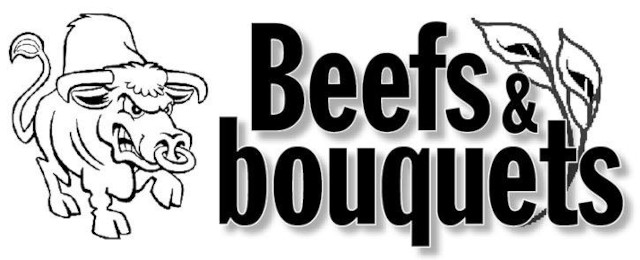 Two "beefs" from the weekly Beefs & Bouquets article in the Nanaimo News Bulletin caught my attention this week. Both concern one of the most dangerous places on our highways: the intersection.
Two "beefs" from the weekly Beefs & Bouquets article in the Nanaimo News Bulletin caught my attention this week. Both concern one of the most dangerous places on our highways: the intersection.

Anticipation Beefs
BEEF To the drivers who slow to a snail’s pace approaching red lights, stop it. Also, stop leaving two car spaces between you and the car in front of you. Traffic can flow better when you drive as you’re expected to drive. Consider ‘zippering’ for the merge action and everyone can move together. Come on folks, do better.
Let's examine the examples given by this beefer:
Watch any heavy truck approaching traffic lights and the driver will anticipate the change to red by slowing down and trying to time their arrival at the queue so that they don't have to stop. It saves time, fuel and wear and tear on the truck.
I can't think of any advantage to sitting in the lineup stopped for the red light.
Leaving two spaces between you and the vehicle in front when stopped at a red light is an example of defensive driving. In a rear end crash, it discourages the accordion effect. If an emergency vehicle approaches, you have room to move out of the way.
I agree with the criticism of failing to use the zipper merge when appropriate, but be careful about defining your expectations. What you expect may not be what everyone else considers proper driving behaviour.
Related Yellow Light Beef
BEEF This is to inform all tailgaters that I disputed an amber light ticket ($168 and two points) and lost. From now on I will be stopping for all amber lights. If you choose not to, and are behind me, I could use a new vehicle.
I found this beef within a few paragraphs of the one discussed above and include it here as the two are related.
Many drivers appear to think that a yellow light means they should step on it because the light is about to turn red. On the contrary, a yellow light means stop, unless it is unsafe to do so.
A good tactic to make it safe to stop is to anticipate the red light and slow down as you approach. That practice gives the driver behind you more time to realize that you are stopping and follow suit.
If they don't and a collision occurs, the violence of the crash could be reduced.
Share This Article
I think a better idea than 2 car lengths is something my Dad told me. When stopping for a red light make sure you can see under the vehicle in front of you. I my opinion that provides an adequate cushion between the two vehicles and doesn’t clog up the street unnecessarily. It also means sometimes it doesn’t allow enough room for any vehicles behind them to move into the right turning lane.
I notice some drivers start slowing down as they approach a green light however every single one that does that usually steps on the gas and goes through the intersection as the light turns red making the driver behind thinking if the moron just continued and not slowed down we both would have easily make the traffic light.
My pet beef is the extremely long distance on highways noting construction ahead. I estimate in some cases it is as long as two kilometres before you find out they aren’t even working that day. A half a Kilometre should be adequate in most cases.
- Log in to post comments
The unnecessary slowing to a red light, pretty much all vehicles except heavy commercial, is unnecessary for fuel savings and blocks access to left hand turn lanes forcing drivers to wait an additional signal cycle to get an activated turn signal.
Leaving two car lengths between vehicles also does the same thing, the chance if an accordian crash is much less after most vehicles have stopped and you can actively reduce the distance between vehicles as the traffic stops at an intersection.
This applies even more so inside the turn lane where there is much less possibility of an accordian crash from main traffic flow.
- Log in to post comments
- Log in to post comments

My Dad Taught Me